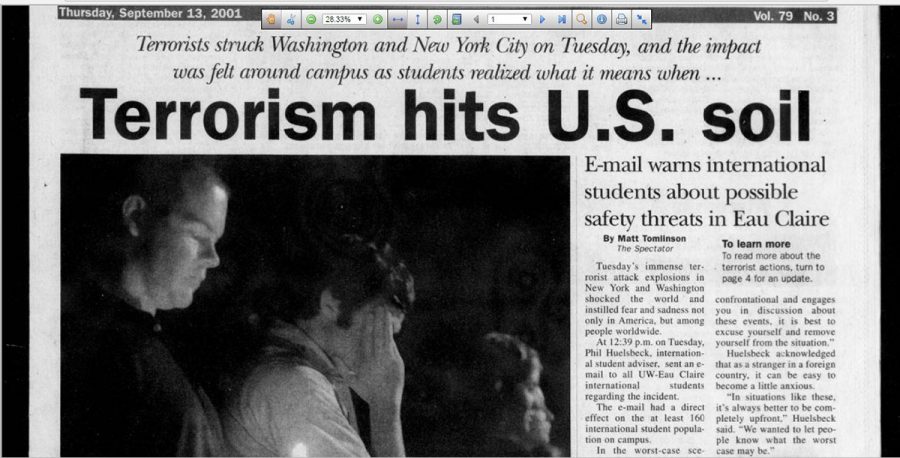The Spectator goes digital
Issues from 1923-2002 are available through university Special Corrections and Archives Department
The digitized Spectator allows everyone to see how the university responded to national events during its history (Courtesy of University Special Collections and Archives)
September 28, 2016
With a click of his mouse, Special Collections Librarian and University Archivist Greg Kocken travelled back in time to 1962. On April 5, The Spectator reported Dr. Martin Luther King Jr.’s arrival to UW-Eau Claire to speak at the Forum.
With another click, Kocken moved to Sept. 13, 2001 where the headline displayed “Terrorism hits U.S. soil” across the front page of The Spectator.
Kocken demonstrated a small portion of the possible uses for the newly digitized Spectator, which has been available to the public for about a month and a half.
Kocken, a 2007 graduate of Eau Claire, has had this project in mind since the start of his career at Eau Claire in 2011.
“One of my goals in my mind was our centennial was coming and I want to have yearbooks, photographs and Spectators online,” Kocken said. “I kind of feel really excited to know that we were able to meet those goals for our centennial.”
Since 1923, McIntyre Library has sent every issue of The Spectator to the Wisconsin Historical Society in Madison, where the issues were bound into volumes and also microfilmed.
Microfilm, Kocken explained, is a length of film containing miniaturized photographs of the newspaper page, and it provides another way to preserve copies of The Spectator.
To John Pollitz, library director, the digitization of The Spectator was the next step to provide better accessibility.
“We made microfilm copies of (The Spectator) but microfilm isn’t searchable,” Pollitz said. “People don’t like to use it.”
Around 2012, Kocken contacted various companies to get a cost estimate, but most quotes were around $20,000, out of their budget. Then, about one and a half years ago, Kocken discovered the Wisconsin Historical Society was digitizing microfilm.
The Wisconsin Historical Society sent Eau Claire samples of digitized Spectator editions, which were tested on the online platform ResCarta, Kocken said.
Pleased with the legibility and search functionality of the samples, Kocken received a full quote from the Wisconsin Historical Society to digitize all the Spectator microfilm from 1923-2002. Pollitz said the quote was around $6000.
At last, Kocken was able to move forward with the project. Last fall, Kocken said he went to the Student Senate’s Information Technology Committee with a bound volume of The Spectator to show the project’s necessity.
“Our earliest volumes, the quality of the paper, the heavy use that it had received over the years,” Kocken said, “It was falling apart.”
By having these records available online, Kocken said, the university could better preserve the physical copies. The Student Senate agreed to fund the digitization project.
Pollitz said the Wisconsin Historical Society completed the scanning last spring, and since then, the staff at Special Collections and Archives has been working to enhance the records to make them more searchable. Finally, all 1800 issues were uploaded to the website.
There are small errors within the collection since there are many steps in the digitizing process, Kocken said, and their team is working to correct them. However, Kocken said these abnormalities are rare and 90-95 percent full coverage of The Spectator collection is now available to the public.
The newly digitized version of The Spectator offers the ability to browse issues by a search term or by date, Kocken said, and he can only speculate as to how the digitized Spectator will be used.
Access is free for everyone, including students, faculty, staff, community members and alumni, and Kocken said he hopes it will be useful as a teaching and learning tool to explore personal and institutional histories.
“It’s a way to kind of peek back into student life and understand how our campus responded to national events as well as understand local events and campus events,” Kocken said.
Senior history student Sarah Beer said her past summer internship would have been easier with the digitized Spectator available. Through July and August, Beer created an exhibition for the Alumni Room on the third floor of Davies Center about the history of Eau Claire’s homecoming.
“My main resource was The Spectator,” Beer said. “So, painstakingly, I went through almost every issue of The Spectator since 1923.” Since the digitized Spectator issues were not yet available, Beer said she had to look through the physical bound volumes, which took weeks of work.
Beer said the digitization project allowed her to learn more about Eau Claire’s history. In addition, Kocken said the digitization of The Spectator will serve as a way to celebrate Eau Claire’s centennial, as it gives students the opportunity to reflect on the institution’s past and explore its history.
Pollitz agreed with that assessment.
“Part of what you do when you celebrate a centennial of a university is you honor the traditions and the history of this institution,” Pollitz said. “It’s always good for current students to be able to get a feel for that, the rich tradition they have here.”
The newly digitized Spectator is available through the Special Collections and Archives page of the Eau Claire website by clicking on the “Digital Collections” tab. Also available for viewing are the Periscope, Eau Claire’s yearbook from 1917-1995, historic photographs and more.

